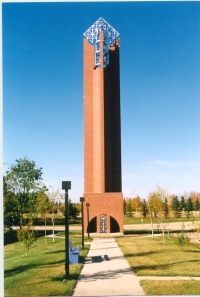


Prior Alfred Mayer (1901-1906) It was at this time that St. John's Abbey in Collegeville, Minnesota was requested to supply priests for a new Catholic colony in Saskatchewan. St. John's Abbey suggested to the Cluniac monks that they relocate to Saskatchewan.
Prior Alfred lost no time. From Jan. 3-16, 1903 he accompanied Fr. Bruno Doerfler on a trip to inspect the territory. The railway took them to Rosthern. From there they went eastward by horse to identify the location of the new abbey.
On Jan. 11, they celebrated the first mass in the colony, in the St. Benedict district (Hoodoo), then visited the district 12 miles south and called it Leofeld. Then the two Benedictines visited Bishop Pascal in Prince Albert and got permission to found a monastery in the Prince Albert Diocese.
By this time 700 homesteads had already been filed in the colony which comprised 50 townships west of 2nd meridian.
On May 12, 1903, eight monks left St. John's to travel to Winnipeg by train. They reached Rosthern, via Regina, by the evening of May 14. May 15 was spent in Rosthern purchasing supplies, food, three teams of horses, three big wagons, a disk and a harrow.
From Rosthern the group divided. At noon on May 15 Fr. Meinrad Seifermann left for Leofeld, becoming the first resident pastor of this first parish of the colony. Fr. Bruno remained behind at Rosthern to welcome the new settlers arriving in great numbers. He stayed there until September, when he returned to St. JohnÕs Abbey for the start of a new school year.
The remaining monks, Prior Alfred, Frs. John Balfrey and Rudolph Palm, candidate Aloysius Gleissner and Brs. Adolph Steiger and Bruno Fuchs, left Rosthern early on May 16, arriving at the Humboldt telegraph station on May 20, where they lodged in a large uninhabited house. It had snowed on May 19.
The next day, May 21, Ascension Thursday, the group reached the homestead section and celebrated the first mass on home territory in a tent. More monks began arriving already in June of 1903 and another 10 monks arrived within a decade.
Living first in a log and mud house, then in a wood monastery the monks started monastic life on the prairies. Their primary task was prayer. They gathered several times a day to pray the monastic office, a practice that has continued without interruption.
The major task that awaited the incoming monks was to locate the pioneer settlers in the colony and begin organizing parishes, erecting churches and residences, and establishing parochial schools for the children.
By 1906 there were 6,000 settlers in the colony. In 1906 the five-year term of Prior Alfred was up and an election of a new prior took place. Fr. Bruno Doerfler was elected.
During Prior Alfred's term of office the number of monks at the monastery had grown to 15. A number of parishes were started and a Catholic newspaper and a printing press were established. In addition Prior Alfred negotiated with the government of the Northwest Territories to have the monastery incorporated.
In June 1906 Prior Alfred returned to St. John's Abbey. He died there on May 29, 1929.